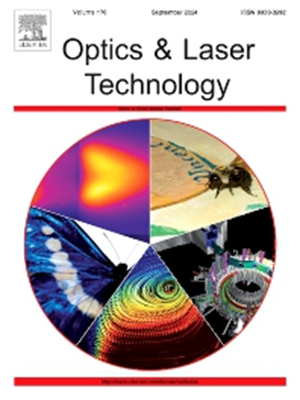Influence of laser heat input on the corrosion mitigation of laser textured AISI 301LN steel in molten carbonate salts
IF 4.6
2区 物理与天体物理
Q1 OPTICS
引用次数: 0
Abstract
Laser Surface Texturing (LST) is a surface modification method to mitigate corrosion of the stainless steels by molten carbonate salts in the concentrated solar power (CSP) plants. In this work, for the first time, the influence of the laser-heat input on the corrosion resistance of AISI 301LN stainless steel is investigated. For this purpose, the effect of the laser power and scanning speed on the surface topography, phase transformation, microhardness, and corrosion behavior, of laser textured surfaces is evaluated in detail. AISI 301LN samples were immersed in molten Li2CO3-Na2CO3-K2CO3 at 600 °C for 500 h. The textured surface properties after LST and the oxide scales formed during corrosion tests were evaluated using microanalysis, microscopy and optical characterization techniques. The results revealed that the effectiveness of LST was improved by increasing the laser-heat input, reducing the scanning speed and increasing the laser power, which is supported by statistical analyses. Compared with an untreated surface, the sample treated with the maximum laser-heat input induced a phase shift from austenite (γ) to martensite (α’), resulting in a remarkable increase in microhardness as well as also significantly decreased the corrosion rate by 37 %. This trend maximized the chemisorption of organic compounds and favoured the homogeneous distribution of Fe-Mn-carbides at the oxide-scale surface formed during the corrosion process. In this way, denser protective oxide scales were formed by retaining Cr and Ni in the oxide layers, and reducing the Li diffusion through scales.

求助全文
约1分钟内获得全文
求助全文
来源期刊
CiteScore
8.50
自引率
10.00%
发文量
1060
审稿时长
3.4 months
期刊介绍:
Optics & Laser Technology aims to provide a vehicle for the publication of a broad range of high quality research and review papers in those fields of scientific and engineering research appertaining to the development and application of the technology of optics and lasers. Papers describing original work in these areas are submitted to rigorous refereeing prior to acceptance for publication.
The scope of Optics & Laser Technology encompasses, but is not restricted to, the following areas:
•development in all types of lasers
•developments in optoelectronic devices and photonics
•developments in new photonics and optical concepts
•developments in conventional optics, optical instruments and components
•techniques of optical metrology, including interferometry and optical fibre sensors
•LIDAR and other non-contact optical measurement techniques, including optical methods in heat and fluid flow
•applications of lasers to materials processing, optical NDT display (including holography) and optical communication
•research and development in the field of laser safety including studies of hazards resulting from the applications of lasers (laser safety, hazards of laser fume)
•developments in optical computing and optical information processing
•developments in new optical materials
•developments in new optical characterization methods and techniques
•developments in quantum optics
•developments in light assisted micro and nanofabrication methods and techniques
•developments in nanophotonics and biophotonics
•developments in imaging processing and systems

 求助内容:
求助内容: 应助结果提醒方式:
应助结果提醒方式:


